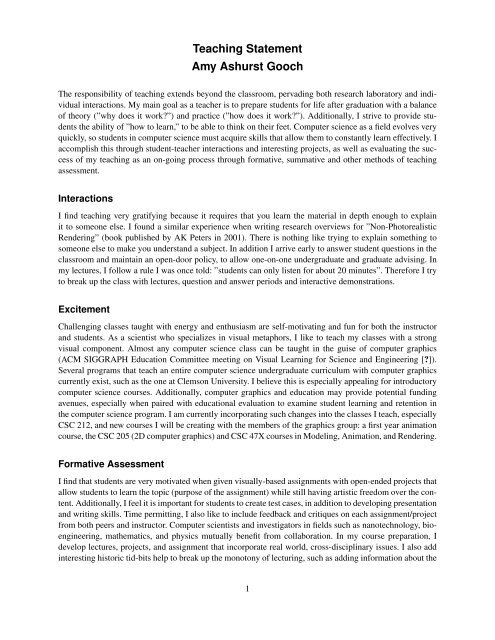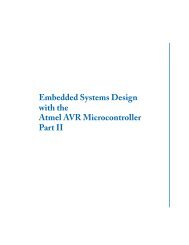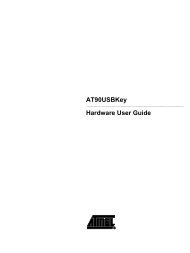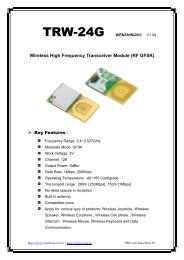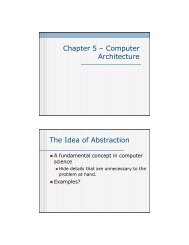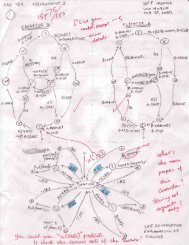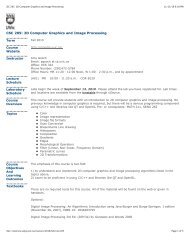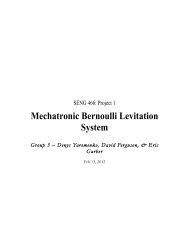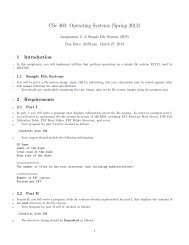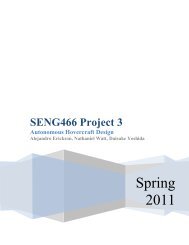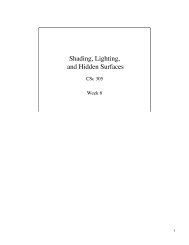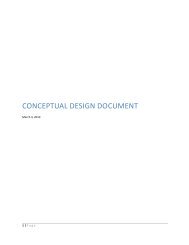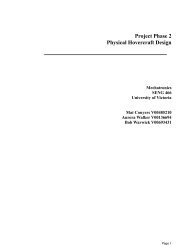Teaching Statement Amy Ashurst Gooch - Department of Computer ...
Teaching Statement Amy Ashurst Gooch - Department of Computer ...
Teaching Statement Amy Ashurst Gooch - Department of Computer ...
Create successful ePaper yourself
Turn your PDF publications into a flip-book with our unique Google optimized e-Paper software.
<strong>Teaching</strong> <strong>Statement</strong><br />
<strong>Amy</strong> <strong>Ashurst</strong> <strong>Gooch</strong><br />
The responsibility <strong>of</strong> teaching extends beyond the classroom, pervading both research laboratory and individual<br />
interactions. My main goal as a teacher is to prepare students for life after graduation with a balance<br />
<strong>of</strong> theory (”why does it work?”) and practice (”how does it work?”). Additionally, I strive to provide students<br />
the ability <strong>of</strong> ”how to learn,” to be able to think on their feet. <strong>Computer</strong> science as a field evolves very<br />
quickly, so students in computer science must acquire skills that allow them to constantly learn effectively. I<br />
accomplish this through student-teacher interactions and interesting projects, as well as evaluating the success<br />
<strong>of</strong> my teaching as an on-going process through formative, summative and other methods <strong>of</strong> teaching<br />
assessment.<br />
Interactions<br />
I find teaching very gratifying because it requires that you learn the material in depth enough to explain<br />
it to someone else. I found a similar experience when writing research overviews for ”Non-Photorealistic<br />
Rendering” (book published by AK Peters in 2001). There is nothing like trying to explain something to<br />
someone else to make you understand a subject. In addition I arrive early to answer student questions in the<br />
classroom and maintain an open-door policy, to allow one-on-one undergraduate and graduate advising. In<br />
my lectures, I follow a rule I was once told: ”students can only listen for about 20 minutes”. Therefore I try<br />
to break up the class with lectures, question and answer periods and interactive demonstrations.<br />
Excitement<br />
Challenging classes taught with energy and enthusiasm are self-motivating and fun for both the instructor<br />
and students. As a scientist who specializes in visual metaphors, I like to teach my classes with a strong<br />
visual component. Almost any computer science class can be taught in the guise <strong>of</strong> computer graphics<br />
(ACM SIGGRAPH Education Committee meeting on Visual Learning for Science and Engineering [?]).<br />
Several programs that teach an entire computer science undergraduate curriculum with computer graphics<br />
currently exist, such as the one at Clemson University. I believe this is especially appealing for introductory<br />
computer science courses. Additionally, computer graphics and education may provide potential funding<br />
avenues, especially when paired with educational evaluation to examine student learning and retention in<br />
the computer science program. I am currently incorporating such changes into the classes I teach, especially<br />
CSC 212, and new courses I will be creating with the members <strong>of</strong> the graphics group: a first year animation<br />
course, the CSC 205 (2D computer graphics) and CSC 47X courses in Modeling, Animation, and Rendering.<br />
Formative Assessment<br />
I find that students are very motivated when given visually-based assignments with open-ended projects that<br />
allow students to learn the topic (purpose <strong>of</strong> the assignment) while still having artistic freedom over the content.<br />
Additionally, I feel it is important for students to create test cases, in addition to developing presentation<br />
and writing skills. Time permitting, I also like to include feedback and critiques on each assignment/project<br />
from both peers and instructor. <strong>Computer</strong> scientists and investigators in fields such as nanotechnology, bioengineering,<br />
mathematics, and physics mutually benefit from collaboration. In my course preparation, I<br />
develop lectures, projects, and assignment that incorporate real world, cross-disciplinary issues. I also add<br />
interesting historic tid-bits help to break up the monotony <strong>of</strong> lecturing, such as adding information about the<br />
1
esearchers behind the techniques (e.g. Phong, Gouraud, Warnock, and Blinn) and other trivia (e.g. origins<br />
<strong>of</strong> the Utah teapot).<br />
After attending the Summer 2008 UVic Learning and <strong>Teaching</strong> Center’s Course Redesign Workshop, I<br />
learned that there is a formalism for activities that students do to practice material they are exposed to in<br />
class, in lab, and in assignments with methods that provide peer and instructor feedback called Formative<br />
Assessment. I’ve now incorporated this concept into my teaching through lab exercises or in class exercises<br />
that include self, peer, or instructor assessment. Peer assessment can be a daunting task for some people,<br />
especially in introductory courses, so I assign them alias that they use for written and online assignments, as<br />
well as critiques, allowing students to remain virtually anonymous.<br />
An example <strong>of</strong> one <strong>of</strong> my formative assessment exercises used when I teach algorithms in CSC212 is to have<br />
students think about building a peanut butter sandwich. I have everyone start with a clean sheet <strong>of</strong> paper,<br />
and place their alias at the top <strong>of</strong> the paper. Students are asked to ”Explain to a 7 year old, how you would<br />
make a peanut butter sandwich. State what things you start with, your initial conditions, and what abilities<br />
do you assume the 7 year old has or instructions they understand? All someone has is what is on your paper;<br />
they have no knowledge unless you specify it. Remember to state your assumptions.”<br />
Students will pass them all in and I’ll pick 3 volunteers to come and execute someone’s instructions using<br />
real bread, peanut butter, etc. (I’ll choose which ones to execute). This in class activity <strong>of</strong> practicing writing<br />
algorithms will be talked about in class with regard to how the algorithms have to be modified to explain<br />
this same task to a computer? (tie in notions <strong>of</strong> function, variables, control logic, etc...)<br />
The in-class practice is followed up by having students assigned a random person’s algorithm, and they are<br />
asked to fix the problems contained in the hand-in version and present their new solution online in a forum.<br />
This way they get exposure to other people’s work, methodology and a chance view a rewrite <strong>of</strong> their initial<br />
solution. There is no right answer, and the students are given participation points, but not graded, allowing<br />
them to practice ideas with out feel <strong>of</strong> penalty.<br />
Summative Assessment As instructors, in the end we have to report summative assessment, ie the<br />
grades we assign to assignments, projects, quizzes, exams, participation. In my courses, especially those<br />
heavily weighted toward projects, I expect everyone to be able to get an A, if the put in the effort. I do not<br />
water down my courses to make this possible, but set up my students to succeed, with the right information<br />
to start with, and assignments that make them do the discovery in a manageable amount <strong>of</strong> time.<br />
<strong>Teaching</strong> Assessment Although I also use student-teacher evaluations to constantly refine the class<br />
lectures and assignments from one class to the next, and one course to the next, I’ve found that this kind<br />
<strong>of</strong> teaching assessment comes too late. In the past I’ve used weekly quizzes to find out what students understand,<br />
and where their understanding fall short. Recently I’ve also incorporated two other assessment<br />
techniques. First I have student hand-in at the beginning <strong>of</strong> each week, the most important 2 concepts from<br />
their assigned reading, and then document the ideas they found confusing. I go through these in class, and<br />
try to aim my lecture to answer their questions. Second, I use a note card every other week, in which students<br />
write on one side their major achievement in this class (a positive thing, to let them think about what they<br />
have learned, what they have achieved) and on the other side, list anything they are confused about or would<br />
like to know more about (their chance to guide where we go next).<br />
New Curriculum Proposed<br />
Co-created new courses approved by faculty for addition in the 2009-2010 calendar year<br />
2
CSC 205: 2D <strong>Computer</strong> Graphics and Image Processing<br />
CSC 471: Fundamentals <strong>of</strong> <strong>Computer</strong> Rendering<br />
CSC 472: Fundamentals <strong>of</strong> <strong>Computer</strong> Modeling<br />
CSC 473: Fundamentals <strong>of</strong> <strong>Computer</strong> Animation<br />
CSC 486: Special Topics in <strong>Computer</strong> Graphics<br />
<strong>Teaching</strong> and Advising Experience<br />
Fall 2008, CSC 485: Generating Animations: S<strong>of</strong>tware & Scripting<br />
Fall 2008, CSC 212: Practical <strong>Computer</strong> Science<br />
Summer 2008, CSC 305: Introduction to <strong>Computer</strong> Graphics<br />
Summer 2008, CSC 490 (Directed Studies): Tom Spreen CubeRoids http://spreenblog.blogspot. com/<br />
Spring 2008, CSC 305: Introduction to <strong>Computer</strong> Graphics<br />
Fall 2007, CSC 591: (Directed Studies): Sven Olsen: Multispectral Imagery for Computational Photography<br />
Fall 2007, CSC 591: (Directed Studies): Sam Ross<strong>of</strong>f: Multispectral Imagery for Computational Photography<br />
Fall 2007, CSC 591: (Directed Studies): Jeremy Long: Multispectral Imagery for Computational Photography<br />
Fall 2007, CSC 212: Practical <strong>Computer</strong> Science<br />
Spring 2007, CSC 485: Special Topics: Computational Aesthetics<br />
Spring 2006, Northwestern University, Games and <strong>Computer</strong> Science. During Spring 2006, I will be<br />
co-taught a Gaming Production and Development for Multiple hardware Platforms, for which we were<br />
given a Micros<strong>of</strong>t Research <strong>Computer</strong> Game Production Curriculum Award <strong>of</strong> $80,000. <strong>Computer</strong> game<br />
design and development provides students with an opportunity to bring together the theory <strong>of</strong> algorithms<br />
and data structures taught in early classes in an engaging and meaningful application. A course on<br />
computer game authoring also fosters teamwork among students, while combining concepts from art<br />
and physics with programming to create a tangible product.<br />
Summer 2004, Spring 2005 Northwestern University, School <strong>of</strong> Continuing Studies, Animation Course.<br />
Fall 2003/2004, Winter 2004, Northwestern University, School <strong>of</strong> Continuing Studies, Introduction and<br />
Advanced <strong>Computer</strong> Graphics Courses. I added a 2-quarter computer graphics class to the curriculum<br />
for pr<strong>of</strong>essionals seeking a Masters Degree in <strong>Computer</strong> Information Systems.<br />
Advising and Undergraduates in research. Over the years as a PhD student Northwestern (2004present)<br />
and as Research Scientist in the Perception and <strong>Computer</strong> Graphics research group at Utah<br />
(1998-2003), I have advised 12 undergraduate students in summer research internships and have gained<br />
an appreciation for the impact teaching and research can have in the direction students take when finishing<br />
their undergraduate career. Also, while working on a master’s degree (1995-1998), I was a teaching<br />
assistant for Utah’s High School Summer Computing Institute and was a guest lecturer in the University<br />
<strong>of</strong> Utah’s Art <strong>Department</strong> Senior and MFA Seminars. Additionally, in teaching my animation class,<br />
3
I’ve been able to interest students in pursuing research projects with faculty to conduct more in depth<br />
learning into topics we could cover only briefly in class.<br />
At the University <strong>of</strong> Victoria, I’ve lead one undergraduate in a directed study, as well as 3 graduate<br />
students on directed studies.<br />
I enjoy developing and teaching. My experience building courses in computer graphics and animation at<br />
both the graduate and undergraduate levels fed a passionate belief that graphics in introductory computer<br />
science classes can attract and retain students, especially females and minorities. I believe that by balancing<br />
theory with visual applications, my students gain the knowledge to not just solve specific problems presented<br />
in class, but the knowledge <strong>of</strong> how they can apply these techniques to solve problems outside the scope <strong>of</strong><br />
the class.<br />
4


